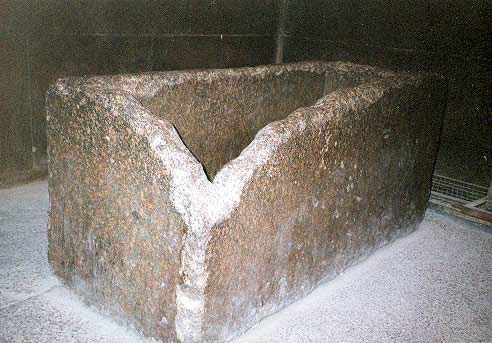
Many books, papers, articles and websites have addressed the who, what, where, when, why and how the Great Pyramid was built. I have presented a case against the GP as the tomb for Pharaoh Khufu by focusing primarily on the person and circumstances surrounding the discovery of the cartouche that is solely responsible for declaring the GP as a tomb for Pharaoh Khufu.
If the Great Pyramid was NOT a tomb, then what was it's purpose? To help answer that question, we must turn our attention to the only physical object found inside the pyramid — the granite Coffer.
THE
COFFER
PHYSICAL
DESCRIPTION:
The Coffer was carved out of a single block of red Aswan granite and hollowed out similar to how a carpenter would hollow out a block of wood with an auger — the spiral markings on the inners sides tells us this. Engineers have estimated it would require very hard bits (some precious stone?) and an overhead pressure of 1-2 tons.
The four sides are about 6 inches thick and the base is about 7 inches thick. There is also a lip along the inside edge of the top that hints of a lid, but no lid has ever been found. The broken corner is the result of people chiseling pieces from of the Coffer to take home with them as a souvenir.
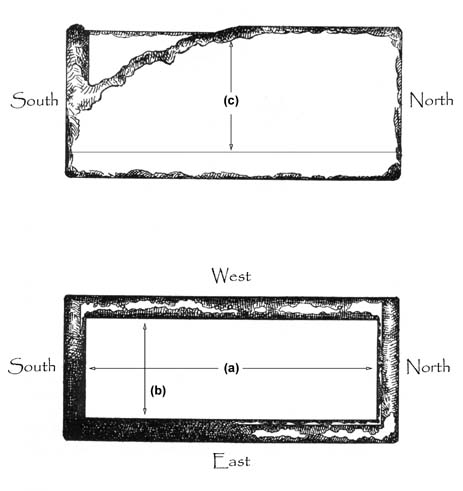
OUTER DIMENSIONS:
(a) Length
= 2278 mm = 89.68 in. = 7.47 ft.
(b) Width = 977 mm = 38.46 in. = 3.2 ft.
(c) Height = 1048 mm = 41.26 in. = 3.4 ft.
INNER DIMENSIONS :
(a) Length
= 1977 mm =77.83 in. = 6.49 ft.
(b) Width = 677 mm = 26.65 in. = 2.22 ft.
(c) Depth = 872 mm = 34.33 in. = 2.86 ft.
Based on the average length of ancient bedframes found in tombs, the average height of an ancient Egyptian adult male was 1.7 m* = 1700 mm = 66.93 in. = 5.58 ft.
Comparing the inner length of the Coffer to the average height of an Egyptian male: (1977 mm vs 1700 mm) the difference = 277 mm (10.9 in.)
CONCLUSION: The average ancient Egyptian adult (male and female) could lay down inside the Coffer with about 188 mm (5.5 in.) clearance to spare at their head and feet. Not a lot of head and foot room, but a body could fit, provided they were not wearing a headdress and other large outer garments.
*Petrie
discovered a bedframe at Tarkhan = 1.76 m
*Queen Hetepheres' bed = 1.77 m
Source:
Ancient Egyptian Magazine, Vol.3, Issue 4, Jan-Feb 2003
MUMMIFICATION
 The ancient Egyptian funeral/burial practice/procedure/process
involved the mummification of the dead body. Between the First
and Third Dynasty (3000-2575 BC) mummification techniques were
used to preserve the physical bodies of the deceased.
The ancient Egyptian funeral/burial practice/procedure/process
involved the mummification of the dead body. Between the First
and Third Dynasty (3000-2575 BC) mummification techniques were
used to preserve the physical bodies of the deceased.
Near the end of the Third Dynasty the organs of the body were removed and placed in canopic jars and/or chest, and the empty body cavity was cleaned and dried. The body cavity was then filled with resin-soaked linen for padding and the body was wrapped with strips of resin-soaked linen. The bandages were also modeled (sometimes with padding) to resemble the features of the body.
In the tomb of Queen Hetepheres (the mother of King Khufu) an alabaster box was found with her internal organs inside; therefore, the mummification process took place during Khufu's time. With that said, we must accept the probability that Pharaoh Khufu's body was mummified, too.
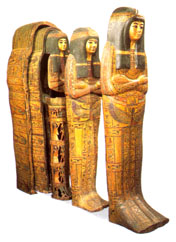 Masks
were molded to resemble the face of the deceased. The mummy mask
of a Pharaoh was made of solid gold, often inlaid with gemstones.
The less important people/mummies wore a mask made of linen or
scraps of papyrus gummed together with plaster or resin (a kind
of paper-mache.)
Masks
were molded to resemble the face of the deceased. The mummy mask
of a Pharaoh was made of solid gold, often inlaid with gemstones.
The less important people/mummies wore a mask made of linen or
scraps of papyrus gummed together with plaster or resin (a kind
of paper-mache.)
Unlike the less important people, the wrapped, mummified body of kings, queens, nobles and other prominant people were placed in an elaborately painted coffin, which was then placed in an elaborately painted mummy case, or nest of mummy cases. This would have been impossible in Khufu's case because the Coffer's interior was barely large enough to fit a human body, let alone another coffin.
BUT let's say mummy cases were not used during Khufu's reign. Fine. But his body was mummified nonetheless. Therefore, imagine Khufu's elaborately adorned, fully wrapped body with many [20?] layers of linen and wearing a large, golden mask laying down inside the very cramped interior of the Coffer - an interior that had only 188 mm (5 inches) of space for the head and foot. Do you think that is how the King of Egypt was laid to rest?
I don't think so.
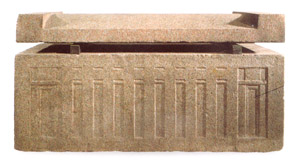
The
granite sarcophagus that were used during the Old Kingdom (2500
BC) had designs inscribed on their exterior. In later years,
the sarcophagus had more elaborate designs and inscriptions on
them. The
stone Coffer inside the King's Chamber of the GP has NO designs
nor any inscriptions.
Nothing. Nothing to denote any (special) purpose whatsoever
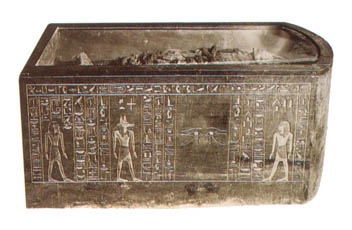
THE CHAMBER
WAS THE KING'S CHAMBER A TOMB?
There is no physical evidence to support this theory. None. No funerary text, no hieroglyphics, nor any artifacts have ever been found to support the idea that the Chamber was a tomb. At best, the only physical evidence found to support anything are the hieroglyphic inscriptions in the upper relieving chambers that simply (and fraudulently?) suggest the GP was BUILT during Khufu's reign.
For me, it makes no sense for such an important person (the KING OF EGYPT) to have a tomb that is completely void of any physical evidence to signify its royal purpose as a tomb.
I have read the classical historians, Herodotus and Diodurus made statements that Cheops (Khufu) was not buried inside the GP but elsewhere. Unfortunately, I cannot find their statements to verify them. Maybe someone reading this can offer this evidence? and perhaps supply some information why these historians made these statements?
LOCATION. LOCATION. LOCATION.
The Coffer is/was too large to fit through the low passageway leading into the King's Chamber (or very, very tight) and too large to fit through the lower section of the ascending passage; therefore, it seems most likely that the Coffer had to have been placed inside the Chamber during the actual construction of the pyramid and BEFORE the Chamber was closed and the passages were sealed.
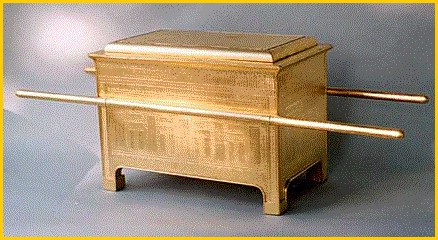
WHAT ABOUT THE ARK OF THE COVENANT ?
According to the Biblical story, The Ark of the Covenant was made of Acacia wood overlaid with gold that was carried by two long bars of Acacia wood also overlaid in gold. It has been said to have contained...
Dimensions
of the Ark (Biblical account — Exodus):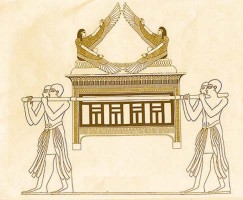
Length
= 2.5 cubits = 1.6 m = 5.2 ft. = 62.5 in.
Width = 1.5 cubits = 0.95 m = 3.1 ft. = 37.5 in.
Height = 1.5 cubits = 0.95 m = 3.1 ft. = 37.5 in.
Dimensions of the Ark (another account):
Length
= 1.15 m = 3.8 ft. = 45.3 in.
Width = 0.7 m = 2.3 ft. = 27.6 in.
Height = 0.7 m = 2.3 ft. = 27.6 in.
Inner Dimensions of the Coffer:
Length =
1977 mm = 6.49 ft. =77.83 in.
Width = 677 mm = 2.22 ft. = 26.65 in.
Height = 872 mm = 2.86 ft. = 34.33 in.
(1) When the dimensions of the Ark are compared to the inner dimensions of the Coffer, it is evident the Ark could NOT have fit inside the Coffer — the Ark was too wide, and according to one account, also too tall.
According to mainstream Egyptology, pyramid building reigned during the Old Kingdom (2700-2200 BC). Given this historical acknowledgment and the (accurate?) fact the Great Pyramid was built during Khufu's reign, we can therefore conclude the GP was completed between 2600-2500 BC.
(2) Biblical chronology however, dates the existence of the Ark of the Covenant from 1440-1460 BC to as early as 1230-1240 BC. These dates place the Ark out of time with the Great Pyramid. In other words, the Ark of the Covenant did NOT exist when the GP was built.
So now you ask, "If the Great Pyramid and the King's Chamber was NOT a tomb, and the Coffer was NOT a sarcophagus, and the Coffer did NOT house the Ark of the Covenant, what was the Coffer's purpose?"
Source:
Eyewitness Books, Mummy by James Putnam
The Great Pyramid Decoded by E. Raymond Capt
|
BACK |
LEARN |